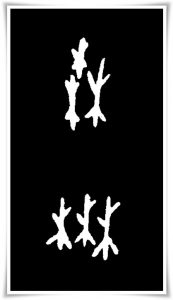
1. Bedeutung:
Wald, Forst
2. Lesungen:
- Kunyomi (訓読み): もり
- Onyomi (音読み): シン
- Japanische Namen: もと
- Chinesische Lesung: sēn
3. Etymologie
森gehört zu 会意文字 (かいいもじ, kaii moji, d.h. zu der Gruppe von Schriftzeichen, die aus einer Kombination von zwei oder mehr Piktogrammen besteht bzw. Schriftzeichen, deren Bedeutung auf einem abstrakten Konzept basiert). 森 folgt einem Konzept von drei Piktogrammen des Schriftzeichens für Baum (木, き, ki), kombiniert in einem einzigen Zeichen und betont somit kräftigen Baumbewuchs, eben Wald.
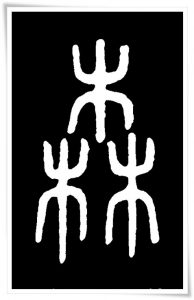
Die Definition des Schriftzeichens 森 ist zu finden in: “Erklärung einfacher Schriftzeichen und Analyse von zusammengesetzten Schriftzeichen” (說文解字, pinyin: Shūowén Jiězì) aus dem 2. Jahrhundert C.E., zusammengestellt von Xu Shen (許慎, pinyin: Xǔ Shèn, ca. 58 C.E. – ca. 147 C.E.), einem Philologen der Han Dynastie (漢朝, pinyin: Hàn Cháo, 206 B.C. – 220 C.E.) mit der Lesung: 木多皃。從林。從木 (pinyin: Mù duō mào. Cóng lín. Cóng mù), d.h. ”Ein starker Bewuchs von Bäumen (in einem Areal), entwickelt aus (dem Ideogramm) Dickicht (林), bzw. aus (dem Piktogramm) Baum (木)”.
Interessanterweise schlägt die Definition des Schriftzeichens für “Baum” (木) in genau demselben Buch auch die Bedeutung “überwuchern des Landes mit starkem Pflanzenbewuchs (Bäumen)” vor.
Heutzutage bedeuten Worte wie 林立 (りんりつ, rinritsu) oder 森立 (しんりつ, shinritsu) “viele Objekte (auch Menschen) aufgereiht nebeneinander stehend”.
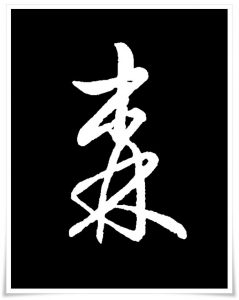
Im Alten Japan glaubte man, dass es im tiefen dichten Wald mit üppigem und riesenhaftem Baumbewuchs viele von Menschen noch unerforschte Orte gibt, in denen Götter wohnten, die ihre göttlichen Geheimnisse für sich behielten. Dies erklärt auch warum das Wort “jinja” (神社, じんじゃ, d.h. “Shintou {神道, しんとう, Shintō} Altar”) in der ältesten Sammlung Japanischer Gedichte Manyoushuu(萬葉集, まんようしゅう, Manyōshū, lit. “Sammlung der zehntausend Blätter”, zusammengestellt in der zweiten Hälfte des 8. Jahrhunderts C.E.) als “mori” (wie das Schriftzeichen森) gelesen wurde.
4. Ausgewählte historische Formen von 森
Figur 1. Verschiedene Orakelknochen-Schrift (甲骨文, こうこつぶん, kōkotsubun) Formen des Schriftzeichens 森, Shang Dynastie (商朝, pinyin: Shāng Cháo, 1600 – 1046 B.C.).
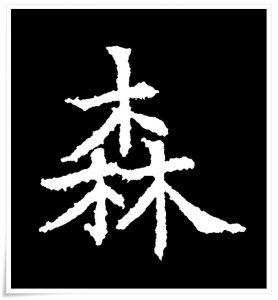
Figur 2. Tuscheabreibung der Kleinen Siegelschrift (小篆, しょうてん, shōten) Form des Schriftzeichens 森, gefunden in “Erklärung einfacher Schriftzeichen und Analyse von zusammengesetzten Schriftzeichen (說文解字, pinyin: Shūowén Jiězì) aus dem 2. Jahrhundert C.E., zusammengestellt von Xu Shen (許慎, pinyin: Xǔ Shèn, ca. 58 C.E. – ca. 147 C.E.), einem Philologen der Han Dynastie (漢朝, pinyin: Hàn Cháo, 206 B.C. – 220 C.E.).
Figur 3. Grasschrift (草書, そうしょ, sōsho) Form des Schriftzeichens 森, zu finden in dem Kalligrafie-Werk mit dem Titel “Phonetisches Wörterbuch in Grasschrift des Ministeriums der Konfuzianischen Riten im Kaiserreich China” (草書禮部韻, pinyin: Cǎoshū Lǐbù yùn ) des Kaisers Qian Long (乾隆, pinyin: Qián Lóng, regierte 1735 – 1796) der Qing Dynastie (清朝, pinyin: Qīng Cháo, 1644 – 1912 C.E.).
Figur 4. Tuscheabreibung der Regelschrift (楷書, かいしょ, kaisho) Form des Schriftzeichens 森. Aus “Grabinschrift für Su Xiaocu” (蘇慈墓誌銘, pinyin: Sū cí mùzhì zhì míng, 538 – 601 C.E.), Soldat und Staatsmann der Tang Dynastie (唐朝, pinyin: Táng Cháo, 618 – 907 C.E.).
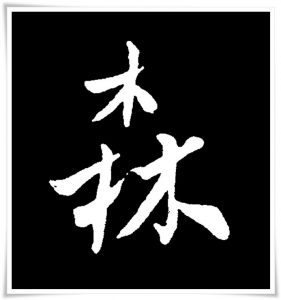
Figur 5. Semi-Kursivschrift (行書, ぎょうしょ, gyōsho) Form des Schriftzeichens 森, zu sehen in der Kalligrafie des außerordentlichen Kalligrafen und hochrangigen Beamten Chu Suiliang (褚遂良, pinyin: Chǔ Suìliáng, 597–658) der Tang Dynastie (唐朝, pinyin: Táng Cháo, 618 – 907 C.E.) mit dem Titel Ku Shu Fu (枯樹賦, pinyin: Kūshù fù, d.h. “Gedicht über den alten verwitterten Baum”), 630 C.E..
5. Nützliche Redewendungen:
- 森林 (しんりん, shinrin): Wald
- 森閑 (しんかん, shinkan): Stille
- 森森 (しんしん, shinshin): stark bewaldet
- 森の奥 (もりのおく, mori no oku): in der Tiefe des Waldes
- 森羅万象 (しんらばんしょう, shinrabanshō): Alle Dinge der Natur, das Universum
Text: Ponte Ryūrui (品天龍涙)
Englische Bearbeitung: Rona Conti
Japanische/Chinesische Bearbeitung: Yuki Mori (森由季)
Deutsche Übersetzung (aus dem Englischen): Antje Goldflam
